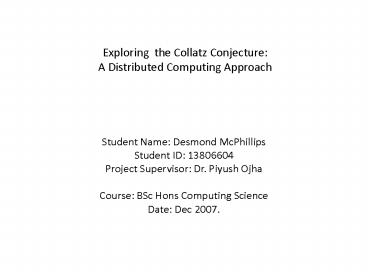Exploring the Collatz Conjecture: A Distributed Computing Approach - PowerPoint PPT Presentation
1 / 16
Title:
Exploring the Collatz Conjecture: A Distributed Computing Approach
Description:
... the application is used when the system is idle and can be used as a screensaver. ... Shall run when the clients machine is idle (possibly as a screensaver) ... – PowerPoint PPT presentation
Number of Views:89
Avg rating:3.0/5.0
Title: Exploring the Collatz Conjecture: A Distributed Computing Approach
1
Exploring the Collatz Conjecture A Distributed
Computing Approach
- Student Name Desmond McPhillips
- Student ID 13806604
- Project Supervisor Dr. Piyush Ojha
- Course BSc Hons Computing Science
- Date Dec 2007.
2
Overview
- Introduction
- What is the Collatz Conjecture?
- Literature Review
- Aims and Objectives
- Requirements analysis and specification
- Initial Design
- Implementation Strategy
- Project Management
3
Introduction
- Mathematical Conjecture
- An Mathematical proposition which is speculated
to be true but has not been proved. - The Collatz Conjecture is one such proposition.
- First proposed by Lothar Collatz in 1937
- The conjecture has eluded and intrigued
mathematicians - Prize fund established to reward the first
person(s) to solve the problem.
4
Introduction
- Easy to state
- The conjecture itself is easy to state the
following iterations of any positive integer will
always end in the Xn 4, Xn1 2, Xn2 1,
Xn3 4 cycle - Xi 1 ½ Xi if Xi is even
- Xi 1 3 Xi 1 if Xi is odd
- Example initial X 6
- 3,10,5,16,8,4,2,1 8 iterations
- Important Numbers 3, 16 and 8
- (These are the statistics gathered, useful for
mathematicians)
5
Literature Review
- Work on the conjecture has been an on-going
process with the majority of the breakthroughs
coming quite recently. - Oliveira e Silva May 2007, verified the range
up to 258 1. - Eric Roosendaal -- June 2007, verified the range
up to 259 2. - Both used computational, distributed approach.
- 1. http//www.ieeta.pt/tos/3x1.html
2.http//www.ericr.nl/wondrous/index.html
6
Aims and Objectives
- The proposed project is quite similar to the
approaches taken above, an application to compute
mass ranges of values and verify the conjecture. - Why re-invent the wheel?
- Key Differences
- Operating System Independence
- Automatic Distribution
- Graphical Interface
7
Aims and Objectives
- Operating System Independence
- The established approaches have been dependant on
the operating system in which they were first
developed. - Proposed project
- Windows
- Unix
- Mac OS
- With a greater range of operating systems
supported, the application can gain wider user
contribution.
8
Aims and Objectives
- Automatic Distribution
- No importance to Silva.
- Roosendaals was restrictive.
- The proposed project is to make the block
acquisition an automatic process. Once a client
has completed a range of number and verified it,
the client is then supplied with another range to
verify.
9
Aims and Objectives
- Graphical Interface
- The proposed project will include a graphical
interface to make the process more meaningful to
the client, especially if the application is used
when the system is idle and can be used as a
screensaver.
10
Requirements analysis and specification
- To make this possible, certain aspects need to be
addressed, such as - Server application
- Shall store information about clients
(identifier, hardware/system environments). - Shall store this information in a back end
database (MySQL). - Shall assign ranges for computation/verification
by clients. - Shall aggregate statistical data from
computations returned by clients
11
Requirements analysis and specification
- Client application
- Shall verify the conjecture on the ranges
assigned to it and gather the statistical data. - Shall be OS Independent .
- Shall run when the clients machine is idle
(possibly as a screensaver). - Shall report to the server on completion and
request a new range to work on.
12
Initial Design
- Below is a prototype of the client side
application interface
13
Implementation Strategy
- Development Language
- Ideal language given the time constraints and
requirements would be Java JNI can be
implemented to offset any computational overhead. - Prototype
- Complete, see prototype GUI.
- Incremental development
- A series of beta releases on a 6-8 week basis
before the final release in April 2008.
14
Implementation Strategy
- Testing
- Due to the nature of the application, access to a
wide range of computers is needed to fulfil a
test condition Wombat Financial Software will be
able to satisfy this requirement with access to
their mass computer network and servers.
15
Project Management
- Since I have decided upon Incremental
development, I have outlined my release goals - Beta release one 17th Dec 2007
- Beta release two 4th Feb 2008
- Beta release three 24th March 2008
- Final release and project report April 2008
16
Summary
- Computational exploration on the Collatz
Conjecture. - Distributed approach to the problem.
- Improve on the current approaches.
- Gather statistical information can be used to
aid mathematical proof. - All aspects completed April 2008
- Any Questions.. ?































